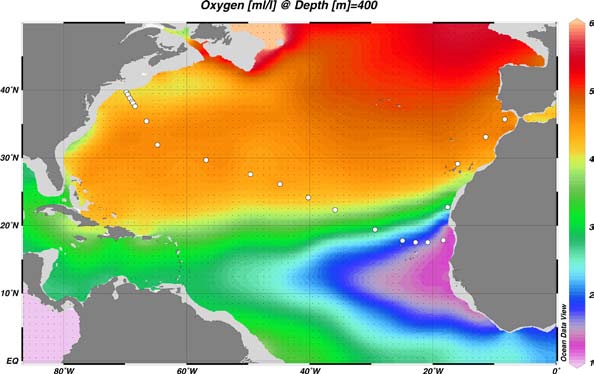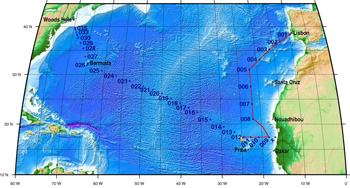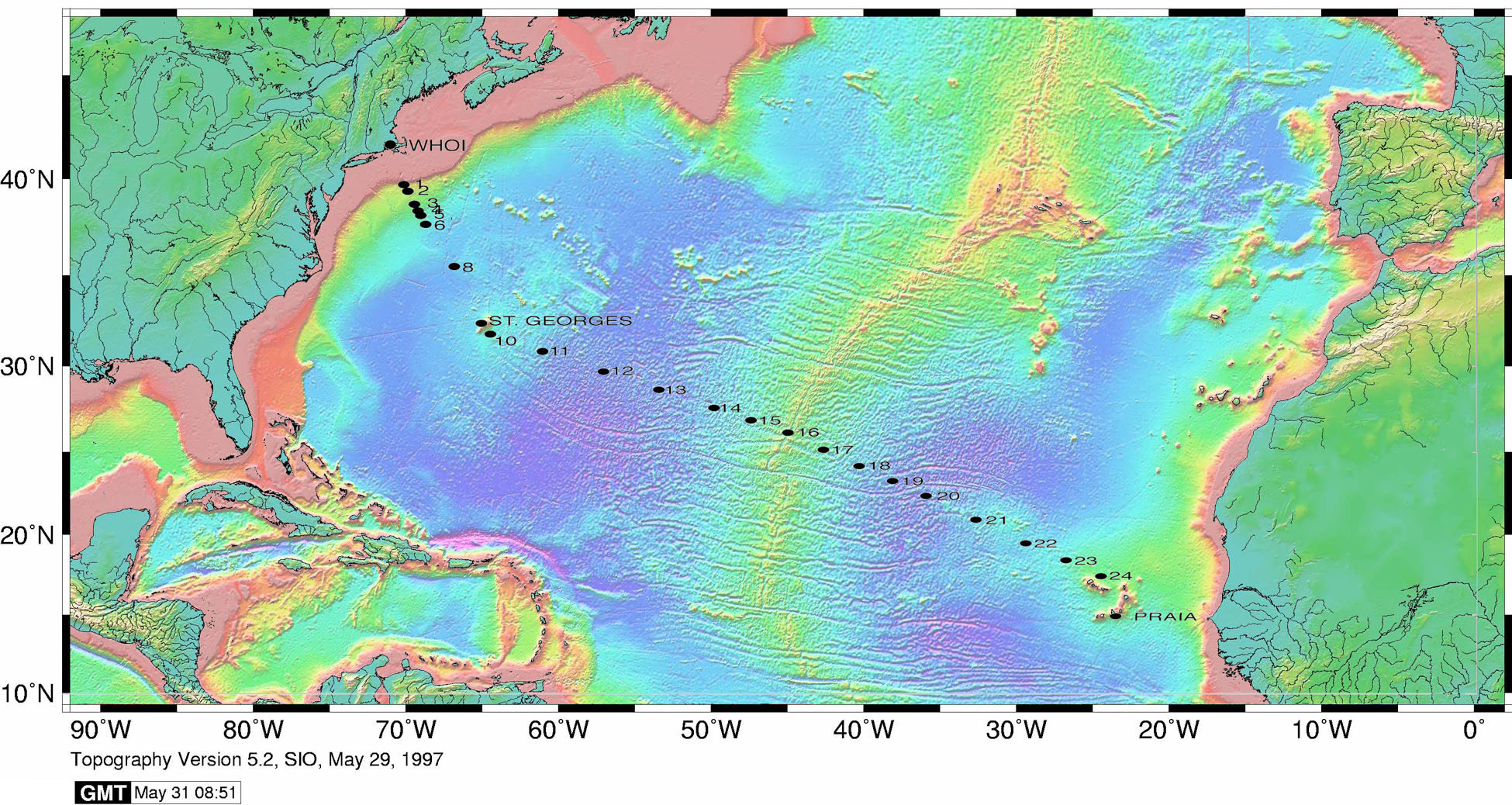Beryllium-7 in aerosol from samples collected on R/V Knorr KN204-01 in the Subtropical northern Atlantic Ocean from November to December 2011
Project
Program
| Contributors | Affiliation | Role |
|---|---|---|
| Kadko, David C. | Florida International University (FIU) | Principal Investigator |
| Rauch, Shannon | Woods Hole Oceanographic Institution (WHOI BCO-DMO) | BCO-DMO Data Manager |
Beryllium-7 in aerosol samples collected on the US GEOTRACES North Atlantic Transect (NAT) cruise, KN204-01.
Aerosol samples were collected between Nov 7, 2011 and Dec 9, 2011 during the R/V Knorr KN204-01 North Atlantic GEOTRACES expedition. Aerosol samples were obtained with a Tisch TE-5170V-BL high volume aerosol sampler, modified to collect 12 replicate samples on acid-washed (Wallace et al, 1977; Baker et al., 2006) 47mm diameter Whatman-41 (W-41) filters, using procedures of the US GEOTRACES aerosol program (Morton et al., 2013). In order to minimize the filter blanks for our experiment, the W-41 filters were pre-cleaned before deployment using three cycles of leaching with 0.5M HCl (Optima) then rinsing with ultra-high purity water (UHP water) according to trace element protocols in a HEPA-filtered laminar flow hood (Morton et al., 2013; similar to Baker et al., 2006).
For 7Be, three of the 47mm aerosol samples were stacked in a plastic Petri dish and counted by gamma spectroscopy. Be-7 has a readily identifiable gamma peak at 478 keV. The counting system was calibrated for all samples by preparing a commercial standard in geometry identical to the samples.
Related references:
Baker, A.R., French, M., and K.L. Linge (2006), Trends in aerosol nutrient solubility along a west-east transect of the Saharan dust plume. Geophysical Research Letters, 33, L07805, doi:10.1029/2005GL024764.
Morton, P.L., Landing, W.M., Milne, A., et al. INTERCAL: Results from the 2008 GEOTRACES aerosol intercalibration study. Limnology and Oceanography: Methods 11, 2013, 62–78.
Wallace G.T., J.R. Fletcher and R.A. Duce (1977) Filter washing, a simple means of reducing blank values and variability in trace metal environmental samples. Journal Environmental Science and Health, AI2, 493-506.
For data processing, please refer to:
Kadko, D. and D. Olson (1996) Be-7 as a tracer of surface water subduction and mixed layer history. Deep Sea Res. 43, 89-116.
BCO-DMO Processing:
- modified parameter names to conform with BCO-DMO naming conventions;
- added cruise_part;
- added ISO_DateTime columns using the original dates/times provided;
- joined additional columns from master file (see below).
Additional GEOTRACES Processing: After the data were submitted to the International Data Management Office, BODC, the office noticed that important identifying information was missing in many datasets. With the agreement of BODC and the US GEOTRACES lead PIs, BCO-DMO added standard US GEOTRACES information, such as the US GEOTRACES event number, to each submitted dataset lacking this information. To accomplish this, BCO-DMO compiled a 'master' dataset composed of the following parameters: station_GEOTRC, cast_GEOTRC (bottle and pump data only), event_GEOTRC, sample_GEOTRC, sample_bottle_GEOTRC (bottle data only), bottle_GEOTRC (bottle data only), depth_GEOTRC_CTD (bottle data only), depth_GEOTRC_CTD_rounded (bottle data only), BTL_ISO_DateTime_UTC (bottle data only), and GeoFish_id (GeoFish data only). This added information will facilitate subsequent analysis and inter comparison of the datasets.
Bottle parameters in the master file were taken from the GT-C_Bottle_GT10, GT-C_Bottle_GT11, ODF_Bottle_GT10, and ODF_Bottle_GT11 datasets. Non-bottle parameters, including those from GeoFish tows, Aerosol sampling, and McLane Pumps, were taken from the Event_Log_GT10 and Event_Log_GT11 datasets. McLane pump cast numbers missing in event logs were taken from the Particulate Th-234 dataset submitted by Ken Buesseler.
A standardized BCO-DMO method (called "join") was then used to merge the missing parameters to each US GEOTRACES dataset, most often by matching on sample_GEOTRC or on some unique combination of other parameters.
If the master parameters were included in the original data file and the values did not differ from the master file, the original data columns were retained and the name of the parameters were changed from the PI-submitted names to the standardized master names. If there were differences between the PI-supplied parameter values and those in the master file, both columns were retained. If the original data submission included all of the master parameters, no additional columns were added, but parameter names were modified to match the naming conventions of the master file.
See the dataset parameters documentation for a description of which parameters were supplied by the PI and which were added via the join method.
| File |
|---|
GT11_Be-7_Aerosol_joined.csv (Comma Separated Values (.csv), 4.04 KB) MD5:63d65ed10559aa72ec32d5666393ca20 Primary data file for dataset ID 671109 |
| Parameter | Description | Units |
| cruise_id | Official cruise identifier e.g. KN199-04 = R/V Knorr cruise number 199-04. | unitless |
| sample_GEOTRC | Unique identifying number for US GEOTRACES samples; ranges from 5033 to 6078 for KN199-04 and from 6112 to 8148 for KN204-01. | unitless |
| station_GEOTRC | GEOTRACES station number; ranges from 1 through 12 for KN199-04 and 1 through 24 for KN204-01. Stations 7 and 9 were skipped on KN204-01. Some GeoFish stations are denoted as X_to_Y indicating the tow occurred between stations X and Y. Values were added from the intermediate US GEOTRACES master file (see Processing Description). | unitless |
| event_GEOTRC | Unique identifying number for US GEOTRACES sampling events; ranges from 2001 to 2225 for KN199-04 events and from 3001 to 3282 for KN204-01 events. Values were added from the intermediate US GEOTRACES master file (see Processing Description). | unitless |
| cruise_part | Part of cruise. For KN204-01: A = 11/6/2011 to 11/18/2011 (Woods Hole to Bermuda); B = 11/19/2011 to 12/11/2011 (Bermuda to Praia, Cabo Verde) | unitless |
| julian_day | Julian day at start of sampling event. | unitless |
| day_start | 2-digit day of month at start of sampling event. | unitless |
| month_start | 2-digit month of year at start of sampling event. | unitless |
| year_start | 4-digit year at start of sampling event. | unitless |
| time_start_utc | Time (UTC) at start of sampling event. 24-hour clock; formatted as HHMM. | unitless |
| ISO_DateTime_UTC_start | Date and time (UTC) formatted to ISO 8601 standard. Calculated from start date and time provided. Format: YYYY-MM-DDTHH:MM:SS[.xx][+/-TZ] | unitless |
| lat_start | Latitude at start of sampling event. North = Positive. | decimal degrees |
| lon_start | Longitude at start of sampling event. West = Negative. | decimal degrees |
| day_end | 2-digit day of month at end of sampling event. | unitless |
| month_end | 2-digit month of year at end of sampling event. | unitless |
| year_end | 4-digit year at end of sampling event. | unitless |
| time_end_utc | Time (UTC) at end of sampling event. 24-hour clock; formatted as HHMM. | unitless |
| ISO_DateTime_UTC_end | Date and time (UTC) formatted to ISO 8601 standard. Calculated from end date and time provided. Format: YYYY-MM-DDTHH:MM:SS[.xx][+/-TZ] | unitless |
| lat_end | Latitude at end of sampling event. North = Positive. | decimal degrees |
| lon_end | Longitude at end of sampling event. West = Negative. | decimal degrees |
| air_vol | Air volume sampled | cubic meter (m^3) |
| Be_7_AER_CONC_TISCH | Be-7 in aerosols | becquerels per cubic meter (bq/m3) |
| Be_7_AER_CONC_TISCH_ERR | Error (+/-) associated with Be-7 measurement | becquerels per cubic meter (bq/m3) |
| Dataset-specific Instrument Name | Tisch TE-5170V-BL high volume aerosol sampler |
| Generic Instrument Name | Aerosol Sampler |
| Dataset-specific Description | Aerosol samples were obtained with a Tisch TE-5170V-BL high volume aerosol sampler, modified to collect 12 replicate samples on acid-washed 47mm diameter Whatman-41 (W-41) filters, using procedures of the US GEOTRACES aerosol program. |
| Generic Instrument Description | A device that collects a sample of aerosol (dry particles or liquid droplets) from the atmosphere. |
| Dataset-specific Instrument Name | gamma spectroscopy |
| Generic Instrument Name | Spectrometer |
| Dataset-specific Description | For 7Be, three of the 47mm aerosol samples were stacked in a plastic Petri dish and counted by gamma spectroscopy. |
| Generic Instrument Description | A spectrometer is an optical instrument used to measure properties of light over a specific portion of the electromagnetic spectrum. |
KN204-01
| Website | |
| Platform | R/V Knorr |
| Report | |
| Start Date | 2011-11-06 |
| End Date | 2011-12-11 |
| Description | The US GEOTRACES North Atlantic cruise aboard the R/V Knorr completed the section between Lisbon and Woods Hole that began in October 2010 but was rescheduled for November-December 2011. The R/V Knorr made a brief stop in Bermuda to exchange samples and personnel before continuing across the basin. Scientists disembarked in Praia, Cape Verde, on 11 December. The cruise was identified as KN204-01A (first part before Bermuda) and KN204-01B (after the Bermuda stop). However, the official deployment name for this cruise is KN204-01 and includes both part A and B.
Science activities included: ODF 30 liter rosette CTD casts, ODU Trace metal rosette CTD casts, McLane particulate pump casts, underway sampling with towed fish and sampling from the shipboard "uncontaminated" flow-through system.
Full depth stations are shown in the accompanying figure (see below). Additional stations to sample for selected trace metals to a depth of 1000 m are not shown. Standard stations are shown in red (as are the ports) and "super" stations, with extra casts to provide large-volume samples for selected parameters, are shown in green.
Station spacing is concentrated along the western margin to evaluate the transport of trace elements and isotopes by western boundary currents. Stations across the gyre will allow scientists to examine trace element supply by Saharan dust, while also contrasting trace element and isotope distributions in the oligotrophic gyre with conditions near biologically productive ocean margins, both in the west, to be sampled now, and within the eastern boundary upwelling system off Mauritania, sampled last year.
Funding: The cruise was funded by NSF OCE awards 0926204, 0926433 and 0926659.
Additional cruise information is available from the Rolling Deck to Repository (R2R): https://www.rvdata.us/search/cruise/KN204-01
Other Relevant Links:
ADCP data are available from the Currents ADCP group at the University of Hawaii at the links below:
KN204-01A (part 1 of 2011 cruise; Woods Hole, MA to Bermuda)
KN204-01B (part 2 of 2011 cruise; Bermuda to Cape Verde) |
U.S. GEOTRACES North Atlantic Transect (GA03) (U.S. GEOTRACES NAT)
Much of this text appeared in an article published in OCB News, October 2008, by the OCB Project Office.
The first U.S. GEOTRACES Atlantic Section will be specifically centered around a sampling cruise to be carried out in the North Atlantic in 2010. Ed Boyle (MIT) and Bill Jenkins (WHOI) organized a three-day planning workshop that was held September 22-24, 2008 at the Woods Hole Oceanographic Institution. The main goal of the workshop, sponsored by the National Science Foundation and the U.S. GEOTRACES Scientific Steering Committee, was to design the implementation plan for the first U.S. GEOTRACES Atlantic Section. The primary cruise design motivation was to improve knowledge of the sources, sinks and internal cycling of Trace Elements and their Isotopes (TEIs) by studying their distributions along a section in the North Atlantic (Figure 1). The North Atlantic has the full suite of processes that affect TEIs, including strong meridional advection, boundary scavenging and source effects, aeolian deposition, and the salty Mediterranean Outflow. The North Atlantic is particularly important as it lies at the "origin" of the global Meridional Overturning Circulation.
It is well understood that many trace metals play important roles in biogeochemical processes and the carbon cycle, yet very little is known about their large-scale distributions and the regional scale processes that affect them. Recent advances in sampling and analytical techniques, along with advances in our understanding of their roles in enzymatic and catalytic processes in the open ocean provide a natural opportunity to make substantial advances in our understanding of these important elements. Moreover, we are motivated by the prospect of global change and the need to understand the present and future workings of the ocean's biogeochemistry. The GEOTRACES strategy is to measure a broad suite of TEIs to constrain the critical biogeochemical processes that influence their distributions. In addition to these "exotic" substances, more traditional properties, including macronutrients (at micromolar and nanomolar levels), CTD, bio-optical parameters, and carbon system characteristics will be measured. The cruise starts at Line W, a repeat hydrographic section southeast of Cape Cod, extends to Bermuda and subsequently through the North Atlantic oligotrophic subtropical gyre, then transects into the African coast in the northern limb of the coastal upwelling region. From there, the cruise goes northward into the Mediterranean outflow. The station locations shown on the map are for the "fulldepth TEI" stations, and constitute approximately half of the stations to be ultimately occupied.
Figure 1. The proposed 2010 Atlantic GEOTRACES cruise track plotted on dissolved oxygen at 400 m depth. Data from the World Ocean Atlas (Levitus et al., 2005) were plotted using Ocean Data View (courtesy Reiner Schlitzer). [click on the image to view a larger version]

Hydrography, CTD and nutrient measurements will be supported by the Ocean Data Facility (J. Swift) at Scripps Institution of Oceanography and funded through NSF Facilities. They will be providing an additional CTD rosette system along with nephelometer and LADCP. A trace metal clean Go-Flo Rosette and winch will be provided by the group at Old Dominion University (G. Cutter) along with a towed underway pumping system.
The North Atlantic Transect cruise began in 2010 with KN199 leg 4 (station sampling) and leg 5 (underway sampling only) (Figure 2).
Figure 2. The red line shows the cruise track for the first leg of the US Geotraces North Atlantic Transect on the R/V Knorr in October 2010. The rest of the stations (beginning with 13) will be completed in October-December 2011 on the R/V Knorr (courtesy of Bill Jenkins, Chief Scientist, GNAT first leg). [click on the image to view a larger version]

The section completion effort resumed again in November 2011 with KN204-01A,B (Figure 3).
KN204-01A,B Cruise Report (PDF)
Figure 3. Station locations occupied on the US Geotraces North Atlantic Transect on the R/V Knorr in November 2011. [click on the image to view a larger version]

Data from the North Atlantic Transect cruises are available under the Datasets heading below, and consensus values for the SAFe and North Atlantic GEOTRACES Reference Seawater Samples are available from the GEOTRACES Program Office: Standards and Reference Materials
ADCP data are available from the Currents ADCP group at the University of Hawaii at the links below:
KN199-04 (leg 1 of 2010 cruise; Lisbon to Cape Verde)
KN199-05 (leg 2 of 2010 cruise; Cape Verde to Charleston, NC)
KN204-01A (part 1 of 2011 cruise; Woods Hole, MA to Bermuda)
KN204-01B (part 2 of 2011 cruise; Bermuda to Cape Verde)
U.S. GEOTRACES (U.S. GEOTRACES)
GEOTRACES is a SCOR sponsored program; and funding for program infrastructure development is provided by the U.S. National Science Foundation.
GEOTRACES gained momentum following a special symposium, S02: Biogeochemical cycling of trace elements and isotopes in the ocean and applications to constrain contemporary marine processes (GEOSECS II), at a 2003 Goldschmidt meeting convened in Japan. The GEOSECS II acronym referred to the Geochemical Ocean Section Studies To determine full water column distributions of selected trace elements and isotopes, including their concentration, chemical speciation, and physical form, along a sufficient number of sections in each ocean basin to establish the principal relationships between these distributions and with more traditional hydrographic parameters;
* To evaluate the sources, sinks, and internal cycling of these species and thereby characterize more completely the physical, chemical and biological processes regulating their distributions, and the sensitivity of these processes to global change; and
* To understand the processes that control the concentrations of geochemical species used for proxies of the past environment, both in the water column and in the substrates that reflect the water column.
GEOTRACES will be global in scope, consisting of ocean sections complemented by regional process studies. Sections and process studies will combine fieldwork, laboratory experiments and modelling. Beyond realizing the scientific objectives identified above, a natural outcome of this work will be to build a community of marine scientists who understand the processes regulating trace element cycles sufficiently well to exploit this knowledge reliably in future interdisciplinary studies.
Expand "Projects" below for information about and data resulting from individual US GEOTRACES research projects.
[ table of contents | back to top ]